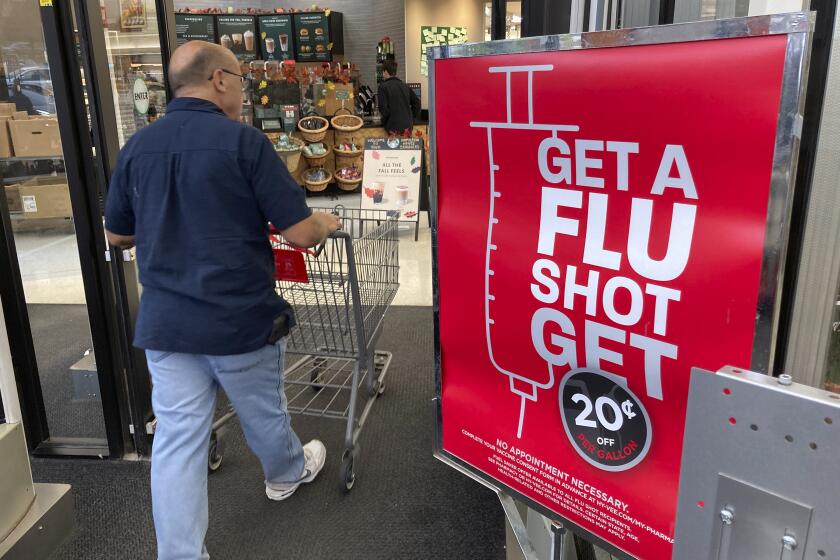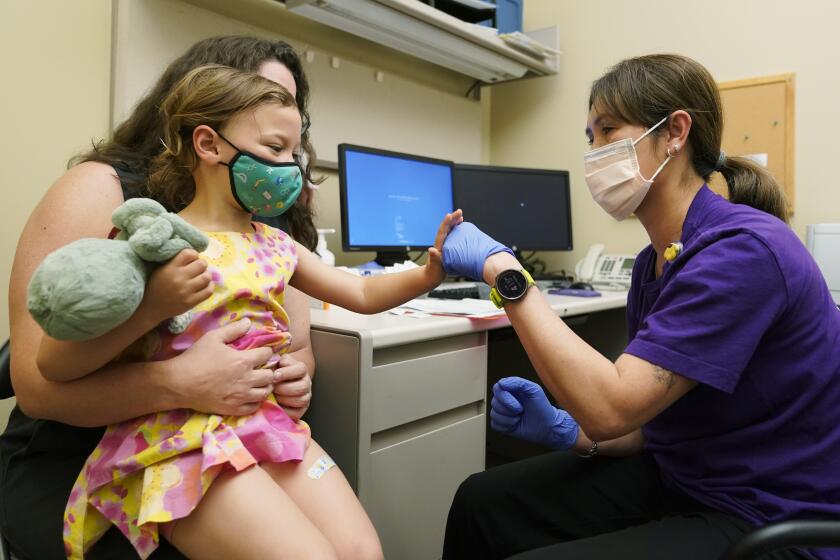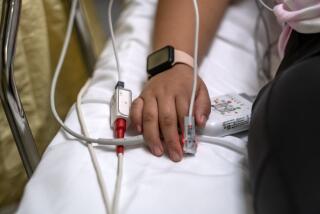‘A huge burden’: L.A. hospitals strained by COVID surge, very bad flu season

- Share via
A “tripledemic” of COVID-19, the flu and RSV is hitting Southern California hard, sending patients to the emergency room in droves and presenting a steep new challenge for a healthcare system already worn thin by nearly three years of the pandemic.
“When you have the convergence of three very serious respiratory viruses, it puts a huge burden on emergency departments and also on the hospital itself,” said Dr. Kimberly Shriner, medical director of infection prevention at Huntington Health.
At Pomona Valley Hospital Medical Center, the emergency room recently hit a record high number of patients in a single day — 382 — according to Darlene Scafiddi, executive vice president of patient care.
“Normally at this time of the year, we’d see about 270,” she said.
To manage the high numbers, the hospital has set up a makeshift flu clinic in an auditorium near the emergency room, staffed with doctors and nurses who can quickly assess and treat patients who can then recover at home.
“If we had a doctor who wasn’t concentrating on those patients that could make a rapid turnaround, they might get busy with a sicker patient” and delay attention for those who could be quickly treated and discharged, Scafiddi said.
Cases and hospitalizations are climbing rapidly, raising the possibility of a renewed public indoor mask mandate.
At the Huntington emergency department in Pasadena, Shriner estimated that twice as many people as usual were coming in daily. For patients who arrive with less severe illnesses or injuries, that can mean “very long” wait times, ranging from six to 11 hours.
“It’s a very long ordeal for people if they walk in with something that’s not really a life-threatening emergency,” she said.
Huntington has set up heated tents outside its emergency department to triage patients, and “we’ve tried to bring on as much staff as we can,” with medical personnel working extra days and travel nurses joining their ranks, Shriner said.
Besides the growing number of people coming to its emergency room, Huntington is also being squeezed as it tries to discharge patients to skilled nursing facilities that are also short on staff, Shriner said.
Patients in need of skilled nursing care “get stuck in the hospital,” she said. “We can’t discharge them until we have a place to put them. And so you can see what happens — it just backs up. And then we don’t have enough beds. And then people sit in the ER for 10 hours.”
At Ronald Reagan UCLA Medical Center, “we are quite busy in our hospital,” said Dr. Annabelle M. de St. Maurice, co-chief infection prevention officer for UCLA Health.
Some single-patient rooms have been converted to accommodate two patients, which means more people may find themselves sharing rooms, she said.
The situation playing out across the Southland is in some ways the manifestation of a long-held fear.
Officials have worried throughout the pandemic about the potential risks of another disease circulating widely at the same time as COVID-19. But while previous “twindemics” failed to materialize in the face of disastrous coronavirus surges, California is now simultaneously contending with a spike in coronavirus transmission, an early onslaught of respiratory syncytial virus, or RSV, and a historically strong start to the flu season.
Influenza has been largely dormant the past two seasons, possibly due to the infection-prevention protocols put in place to ward off the coronavirus.
According to the U.S. Centers for Disease Control and Prevention, the cumulative flu hospitalization rate nationally is higher for this time of year than every season since 2010. The agency considers flu levels in California to be “very high” and among the worst in the country.
The number of flu hospital admissions nationwide has doubled in a week, and the CDC estimates 4,500 people have died from the disease since the start of October. Over the same time period, roughly 25,000 COVID-19 deaths have been reported.
Whether this early onslaught will result in an earlier-than-usual end to the flu season or is the harbinger of difficult months to come is unclear.
Hospitals have also for weeks grappled with RSV, which can cause significant illness, respiratory distress and even death. Young children and older people are particularly at risk.
“We were seeing viruses hit pretty hard before RSV hit. And then RSV hit on top of that. And now flu and COVID are hitting on top of that,” said Dr. Coleen Cunningham, senior vice president and pediatrician in chief at Children’s Health of Orange County.
At the hospital in Orange, “the numbers are really unprecedented,” and the emergency room is seeing more than 400 children each day, said Cunningham, who is also chair of pediatrics at UC Irvine.
“Everybody in the pediatric community — whether it’s at CHOC or other institutions — are really stepping up, but are stretched,” she said. “This has been going on for a while, and people are getting tired.”
At CHOC, to help move children into hospital rooms more quickly, a theater where hospitalized children had been able to watch movies has been repurposed as a “discharge lounge” for those ready to go home but awaiting a ride or instructions for their families.
Playrooms have been converted for patients to use. Beds have been set up in the hallway of the emergency room with privacy screens around them, she said. The viral pile-on means that the hospital has to be careful about rooming children together, complicating its scramble for space.
The number of coronavirus-positive patients hospitalized statewide has climbed rapidly in recent weeks. The total census as of Wednesday — 4,387 — has swelled 52% since Thanksgiving.
At the peak of last summer’s Omicron wave, as many as 4,843 coronavirus-positive patients were hospitalized statewide on a given day.
Based on previous statewide trends, roughly 55% of such individuals are likely not hospitalized specifically for COVID-19 but tested positive when seeking care for some other reason.
In any case, officials point out those infected with the coronavirus can place additional strain on healthcare facilities as they require additional resources to ensure they don’t transmit the virus to others.
Also on the rise are coronavirus-positive hospital patients, raising the specter of an indoor public mask order in L.A. County.
So far, the current coronavirus wave is nowhere near as large as the last two fall and winter surges. And there is optimism that a high level of vaccine coverage as well as the availability of updated boosters and effective therapeutics will keep this surge from reaching those same harrowing heights.
However, the ultimate confluence of COVID-19, flu, RSV and other respiratory illnesses remains unclear.
In Los Angeles County, coronavirus case and hospitalization rates continue to worsen, raising the possibility of a renewed indoor mask order in indoor public settings as soon as early January.
For the first time since summer, L.A. County on Thursday entered the high COVID-19 community level — in which the CDC recommends universal masking in indoor settings. But there are initial signs the rate of increase in cases and hospitalizations is slowing.
“The rate of increase has actually diminished these last three days,” county Public Health Director Barbara Ferrer said Thursday. “I’m feeling more hopeful that our metrics might improve. I really do. I could be wrong, and that’s why the crystal ball questions are so difficult.”
The rate of new coronavirus-positive admissions over the last week climbed by 24%, a softer jump than the prior week-over-week increase of 38%. And the share of staffed hospital beds being used by coronavirus-positive patients climbed 23% from the prior week, a gentler increase than last week’s jump of 40%.
It’s unclear when L.A. County would hit the final trigger that could begin a two-week countdown for an indoor mask order. The most recent estimate was for a few days before Christmas, but recent improvements are pushing back that date later — if at all.
Pomona Valley has seen its numbers of COVID-positive patients roughly triple from a month ago, Scafiddi said, and the majority are sick with COVID-19 rather than incidentally infected. Growing numbers of people are being hospitalized for flu and RSV as well.
This surge has hit children and teens differently. As COVID-19 cases spiked last winter, the Pomona hospital closed its pediatric unit to make room for adult patients, according to Scafiddi. This year, as COVID-19 and other viruses are spreading, it has had as many as 18 pediatric patients at a time — triple the usual number for this time of year, she said.
The hospital has not had to cancel surgeries or set up a tent outside, and Scafiddi said officials are not worried about supplies nor had trouble with staffing, thanks to bringing in traveling nurses. The hospital also is well-stocked with Paxlovid to treat COVID-19 patients, she said.
De St. Maurice, who is also an associate professor of pediatric infectious diseases at UCLA, urged families to get children vaccinated against flu and COVID-19 and to be more cautious about sending children to daycare or gatherings if they have any symptoms.
U.S. regulators have cleared pediatric doses of the updated COVID-19 vaccines to children ages 6 months to 5 years.
“Even though they may test negative for COVID, that doesn’t mean they’re in the clear,” since influenza, RSV and other viruses are circulating, she said.
At Huntington, Shriner said that as hospitals brace for another winter with COVID-19, “we certainly know how to handle it better and we’re in much better shape now than we ever were before. But it’s challenging.”
She urged people to get their flu shot and take other precautions: “There’s just so many things we can do, not the least of which is the simple stuff. Wear a mask. Get tested a lot.
“We know how to do this,” Shriner said, but “nobody wants to do it. “They want it to be like before COVID. Well, that’s gone. Now we know what this thing can do. And there’s other viruses out there, not the least of which is influenza.”
Cunningham urged people to avoid exposing their children to sick people, keep sick children home from day care or school, wash their hands frequently and wear masks indoors, if possible.
“It’s not a good time to tax the system,” she said, “because we’re already pushed pretty hard.”
More to Read
Sign up for Essential California
The most important California stories and recommendations in your inbox every morning.
You may occasionally receive promotional content from the Los Angeles Times.

















